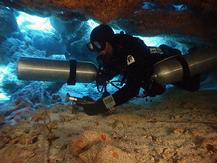Side mount does seem like it's becoming more trendy.
Yes, I think you are right. Similarly, rebreathers seem to be becoming more trendy as well. I guess, new / somewhat unique gear configurations attract interest. (After all, don't some of us get into diving because we are fascinated with the gear, more than the fish?) I suspect a number of people try sidemount, and decide that their backmount rig is just as easy / convenient. Others become bitten by the bug.
I listened to a Pod Diver pod cast interview a while back with one of the people credited with the development of the side mount configuration.He described a pretty specific set of circumstances for their use...... they seem to have gained favor among a variety of divers now-a-days. Much different that what was discussed in the interview
I am curious, who was being interviewed, and what was the specific set of circumstances they described (I can probably guess on that part)?
Dive-aholic made a helpful characterization last year in a post, regarding the distinction between sidemount diving, and diving a sidemount configuration. What you see in the environment of origin (caves) is sidemount diving, diving in a manner required to meet the demands of exploration, through restricted openings, etc. Diving a sidemount configuration in contrast is really more about diving a particular gear set-up - i.e. independent doubles vs manifiolded doubles, tanks mounted at your sides vs tanks mounted on your back. (Personally, I like both, I dive both, and I see advantages and disadvantages to both configurations.) And, open water sidemount diving (diving a SM configuration in the OW environment rather than only the cave environment) has become more popular - part of that is probably a bit of a fad, but part of it is a matter of preference. One thing a sidemount configuration does offer that is appealing (to me at least) is a whole lot of opportunity for DIY development and experimentation. For gear junkies, SM is probably still more of the 'open range' than back-mount, although that is a very general observation, with which, I am sure, someone will disagree.

Is side mount more of a regional development?
Probably, the distribution of interest was initially more of a reflection of the availability of caves, and therefore the presence of cave divers.
Or is it a case of divers having issues with big doubles rigs, that is driving the apparent growth of side mount.
There is an element of that as well. I know of at least one very vigorous advocate of SM diving who moved in that direction after an injury compromised his ability to walk any distance (or, more to the point, manage stairs or inclines on shore, carrying heavy cylinders (double 130s) on his back. Personally, I find it A LOT easier to re-board a boat, if I can hand up one of my main cylinders (as I do with deco bottles anyway) than to climb the ladder with double 130s on my back; I will get up the ladder and back on board, but it may not be pretty. AL80s, and HP 100s, not as big an issue.
Wookie:
Some enterprising instructor somewhere figured out that sidemount wasn't as hard on your back, so folks not otherwise physically fit to dive are now able to pursue the sport. This presents a problem in my mind. If you can't tote the gear, should you be participating in this sport?
And, that's a tough issue, because of some interesting exceptions (SUDS, possibly, being one that would evoke some very visceral reactions). But, I am not sure it was as much a matter of being 'not otherwise physically fit to dive', as having limitations that could be overcome by a simple gear adjustment. We make plenty of gear adjustments for people who are 'differently abled'. Is SM all that different in that regard?
One other benefit I see with the sidemount configuration - it is a chance for some divers to take a tentative step into diving doubles, to 'test the water', without the 'hassle' of rigging up a set of banded double tanks. That doesn't mean it is less expensive. But, many people have two (or more) tanks, and more than a few have (at least) two regs, and it is probably just a little easier to set up a SM rig than to set up banded, manifolded doubles - again a somewhat general statement.








